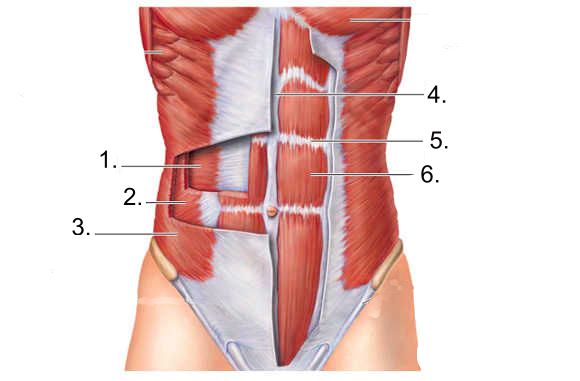Abdomen
Chapter Conclusion
Learning Objectives
- Identify the 4 primary abdominal muscles and know their origin, insertion, actions, and nerve innervation.
- Identify visceral organs in the abdomen and be able to describe their function, relation with one another, and important anatomical features.
- Identify the 2 main hormones of the pancreas and explain their importance.
- Develop a general understanding of some of the main clinical conditions in the abdomen.
Check Your Understanding
Part A.
1. Which of the following is the deepest abdominal muscle?
a) internal obliques
b) external obliques
c) rectus abdominis
d) transverse abdominis
2. Which of the following muscles has their fibers positioned on an angle, moving from a lateral-medial in an inferior direction? (imagine putting your hands in your pockets)
a) internal obliques
b) external obliques
c) rectus abdominis
d) transverse abdominis
3. The rectus abdominis has 3 muscles bellies that are separated by?
a) linea albas
b) tendinous inscriptions
c) abdominal aponeurosis
d) rectus lines
4. The ureter is feature of the __________ and its function is to _____________.
a) liver, transport urine to the urinary bladder
b) liver, transport bile to the gallbladder
c) kidney, transport urine to the urinary bladder
d)kidney, transport bile to the gallbladder
5. Which of the following is not a lobe of the liver?
a) caudate lobe
b) quadrate lobe
c) left lobe
d) intermediate lobe
e) right lobe
6. The _________ controls the flow of chyme from the stomach to the duodenum.
a) cardia sphincter
b) pyloric sphincter
c) fundus
d) cecum
7. Which of the following highlights the correct order of a substance entering the small intestine, to leaving the small intestine?
a) duodenum, jejunum, ileum
b) jejunum, duodenum, ileum
c) duodenum, ileum, jejunum
d) ileum, duodenum, jejunum
8. What is the main function of the spleen is?
a) produce bile
b) digestion of carbohydrates
c) location of immune response
d) regulates fluid volume
9. The appendix is a feature of the __________.
a) small intestine
b) colon
c) rectum
d) cecum
10. The most common type of lower back pain is caused by?
a) sacroiliac joint syndrome
b) herniated disc
c) muscle strains
d) none of the above
Part B.
For the following true of false questions, circle T if you think the answer is true and circle F if you think the answer is false.
- The internal obliques are larger than the external obliques. T / F
- The linea aspera divides the rectus abdominis in half. T / F
- The kidneys receive blood via renal arteries. T / F
- Bile enters the gallbladder via bile ducts. T / F
- The esophagus meets the stomach at the cardia. T / F
- The small intestine turns into the large intestine at the ileocecal valve. T / F
- The pancreas has endocrine and exocrine functions. T / F
- Splenic ruptures usually occur when a left rib is broken and punctures the spleen. T / F
- The rectus abdominis plays a critical role in forced inspiration. T / F
- The abdominal aorta branches off into right and left common iliac arteries. T / F
Part C.
In the pancreas, the hormones that are responsible for regulating blood sugar levels are insulin and glucagon. Listed below, are a number of different characteristic of these 2 hormones. Your job is to match the characteristics to the correct hormone. In the hormone box, write the #’s from the description that correctly match the hormone.
| Insulin | Glucagon | Description |
|
Part D.
For the following questions, correctly match the anatomical features to the diagram.

| Questions | Features |
|
|
A. external obliques
B. rectus abdominis C. transverse abdominis D. tendinous intersections (inscriptions) E. linea alba F. internal obliques |
Answer key
Part A.
1. d 2. b 3. b 4. c 5. d 6. b 7. a 8. c 9. b 10. c
Part B.
1. F 2. F 3. T 4. F 5. T 6. T 7. T 8. T 9. F 10. T
Part C.
| Insulin | Glucagon | Description |
| – 1, 4, 5, 7, 10 | – 2, 3, 6, 8, 9 |
|
Part D.
- C 2. F 3. A 4. E 5. D 6. B

